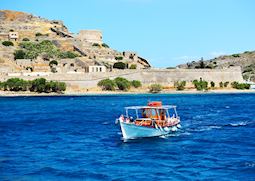A sprawling palace that may have inspired the myth of the Minotaur’s labyrinth, the Palace of Knossos is one of the most important Bronze Age sites in all of Europe. A visit to these evocative ruins is foundational in understanding the history of this once-powerful, but often-forgotten, people as well as their enormous effect on the early Mediterranean, especially classical Greece. Spend a morning on a privately guided tour to learn more about this long-gone culture.
A highlight is the palace’s Throne Room, where King Minos himself once reigned. It’s decorated with still-vibrant mosaics that depict griffins. You’ll also get a chance to examine the remains of the palace’s sophisticated heating and cooling systems — this advanced engineering was the height of luxury during the middle Bronze Age. Additionally, you’ll be able to visit a local vineyard for a tasting of six different vintages accompanied by traditional Greek nibbles.
You’ll be picked up by your private guide at your hotel and driven to the palace, which is located on the island’s northern shore. The Bronze-Age Minoan people dominated this part of the Mediterranean from 1450 to 1400 BC, and Knossos formed their capital on Crete. The ruins are vast — the sprawling site includes courtyards, private rooms, bath houses and the palace itself. A private guide can help make sense of the complex maze of stone walls and evocatively broken rooms.
What you see will be tailored to your particular interests, of course, but the Throne Room is a major highlight. The simple alabaster throne seems understated for the ruler of such an important kingdom, but this is because it might have been the first throne room in all of Europe.
What the seat itself lacks in grandeur is balance by the impressive frescoes. Even today, the red paint that dominates the walls is shockingly crimson and you can make out the detail on the elegant griffins that flank the royal chair. Near the Throne Room, you can visit where archaeologist Sir Arthur Evans uncovered the so-called Snake Goddess statue and learn about why this, one of the most commonly reproduced statues from antiquity, is probably not a goddess.



